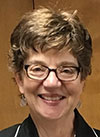Research indicates that 1 in 10 older adults experiences elder abuse. In 2010, there were 5.8 million people age 85 or older, and by 2050, it is projected that there will be 19 million people age 85 or older.
 Gretchen Viney, U.W. 1978, is a Distinguished Clinical Professor and Director of the Lawyering Skills Program at the U.W. Law School. She chairs the Content Subcommittee of the Wisconsin Lawyer’s Editorial Advisory Board.
Gretchen Viney, U.W. 1978, is a Distinguished Clinical Professor and Director of the Lawyering Skills Program at the U.W. Law School. She chairs the Content Subcommittee of the Wisconsin Lawyer’s Editorial Advisory Board.
According to the 2018 Wisconsin Annual Elder Abuse and Neglect Report: that year county agencies received 8,792 referrals for elder abuse, approximately a 3.7 percent increase over 2017. Removing the cases of self-neglect and calls made simply for informational purposes, 3,340 referrals were made for elder abuse, or roughly nine referrals per day in Wisconsin in 2018.
The numbers are staggering. The largest category of elder abuse in Wisconsin in 2018 (other than self-neglect) was financial exploitation. Nationally, the cost of elder financial exploitation is estimated to be at least $2.9 billion and as much as $36.5 billion annually.
Because abuse of older clients can occur in any setting and manifest across many different practice areas and legal matters, civil lawyers are positioned to help their older clients avoid or end the abuse. Beginning this month and continuing at least through June, the Wisconsin Lawyer will feature a series of articles to help lawyers better serve older clients who may be vulnerable to abuse.

This Issue: Series on Protecting Older Clients
Gretchen Viney introduces a
series of articles that focus on the
many ways lawyers can help older
clients avoid or end elder abuse.
An Overview: Older Clients & Elder Abuse
This overview kicks off a series of articles that focus on how
lawyers can help older clients avoid or end elder abuse. Learn
how to recognize potential abuse and develop a holistic
understanding of the legal needs and perspective of older
clients.
Screening for Elder Fraud and Abuse
A lawyer’s powers of observation and note-taking, recordkeeping,
and organizational skills can go far to identify
and help older clients who are vulnerable to abuse. Learn
appropriate techniques to screen older clients for fraud and
abuse.
Elder abuse – whether domestic violence, financial exploitation, caregiver mistreatment, or any of a multitude of types of elder cruelty – is sure to continue in the news as our population ages. What do we know about elder abuse? What does it mean? How can we protect elders while safeguarding their autonomy? What are the latest scams? Which public systems and protections are already in place? What can lawyers do to prevent or stop elder abuse? The elder abuse series represents our efforts to answer these questions and more.
This series was the brainchild of the Content Subcommittee of the State Bar Communications Committee, which serves as this magazine’s editorial advisory board. We chose to create a series instead of a more traditional focus issue so that we could explore this serious topic more intentionally. The small seed of the idea came to life under the enthusiastic leadership of attorneys Juanita Davis, Ann Laatsch, and Iris M. Christenson. They have created a provocative, powerful series that will almost certainly result in important conversations and actions.
This month’s overview article, “Older Clients & Elder Abuse,” provides background and a roadmap for this series. A second article, “Screening for Elder Fraud and Abuse,” gives lawyers tips for doing just that. I hope you will take advantage of the expertise of our contributors by reading and responding to the wide array of content that you will see in the coming months.
I extend a sincere thank you to Juanita, Ann, and Iris and managing editor Karlé Lester for their enthusiastic work on the series and also to the many authors who are participating in it.
